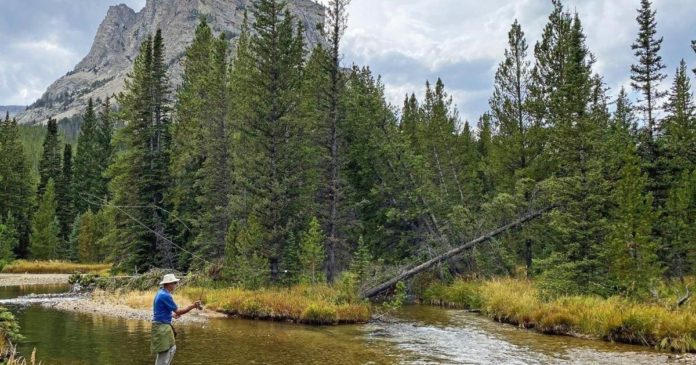The center seat of a fishing boat often doubles as a soapbox, where professional guides like me might spout frothy yarns, broadcast ironclad instructions and proclaim our program as “the way.” But when we shut the heck up, we generally find the bow and stern occupied by folks who inspire us to listen … and learn.
One of my most memorable days listening and learning happened two and a half years ago as I guided scientist Clint Muhlfeld, Ph.D. and journalist Chris Solomon on my home water, the North Fork of Montana’s Flathead River. Chris, on assignment with National Geographic Magazine, was interviewing Clint and me on how climate change impacts fisheries.
As we discussed the decline in native trout populations, Clint, a research aquatic ecologist with the U.S. Geological Survey, explained how warming glacial waters and shifting streamflow regimes are agreeable to non-native rainbow trout, enabling their hybridization with native westslope cutthroat trout. He said this union could be detrimental to the persistence of native trout in the one of the most intact freshwater ecosystems in North America.
People are also reading…
At the time, Clint also gave us the scoop that 20,000 fish surveys collected over the last three decades were being compiled into a pending science paper about the impacts of climate change on native fish across the northern Rockies.
The peer-reviewed paper, recently published in Science Advances, reveals how the warming hurts native bull trout and cutthroat uniquely, offering new insight for resource managers.
It details how native westslope cutthroat possess key genetic adaptations allowing them to withstand increasing temperatures. And, that hybridization breaks up the coadapted gene complexes that are programmed for the locally adapted traits, so climate-induced hybridization is likely to reduce their fitness and ability to adapt to changing climate conditions as they’ve done for millennia, even during warmer periods.
Meanwhile, the paper explains, it’s not the non-native species bumming the bull trout in local streams and rivers, it’s that rivers with rising temperatures and less streamflow become uninhabitable to the threatened char species. The study shows us how climate change can directly and indirectly affect habitats and species interactions.
The paper reflects next-level modeling to predict more accurately into the future and gives us ammunition to fight to protect the resource. I say “us” because while it’s our elected leadership that imparts environmental policy, it’s up to us as stakeholders to support those measures.
Good guiding comes by way of far more than shoveling water and selecting proper stonefly patterns. In the last decade, more guides have stepped up to testify on the changes we’ve witnessed from the center seat, including altered runoff, reduced streamflow, species hybridization, damaged spawning, increased nutrient loads and water temperatures that are fatal to fish. So, it’s wildly encouraging to see a detailed report supporting opportunities for conservation.
I’m proud to work on coldwater fisheries that contribute nearly $650 million each year to our state’s economy. Healthy fish are crucial to our economy, to the health of the greater ecosystem and to our cultural richness. That’s why fly-fishing industry leaders nationwide are joining conversations about green banking, electric vehicles, updating the electric grid, sustainable agriculture, carbon neutrality and carbon pricing.
I’m grateful to peers who helped my fly shop, Lary’s Fly and Supply in Columbia Falls, achieve carbon neutrality and I’m thrilled that more fly shops are pursuing this action. My business is reliant on clean rivers. And, as a parent to three adult children who I’m fortunate enough to work alongside, it’s not possible for me to fly-fish without addressing the climate crisis. Conversely, I would not understand environmental impacts so directly if not for my family’s intimacy with the river.
In fly fishing, we work within thin margins, acknowledging that environmental policy changes are also made at the margins. With approximately 50 million members of the outdoor community in the United States, we have a mega impact at those thin margins when we influence legislators to approve climate crisis solutions.
Right now, this means voicing to the U.S. Senate and President Biden that the powerful and growing outdoor community wants climate provisions to remain in the Build Back Better bill, which is still under negotiation. There are easy ways to express this, including through this link on the Citizens Climate Lobby site: citizensclimatelobby.org/get-loud-take-action/
Equipped with scientific facts, Montana grit and support from each other, we are all in the center seat. We’ve listened, we’ve learned and we have the authority and responsibility to guide our elected leaders toward solid climate policy to protect our livelihoods and legacy.
Hilary Hutcheson is a fly-fishing guide in northwest Montana.
Credit: Source link































